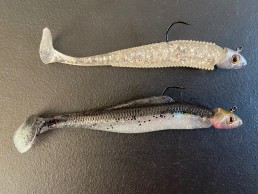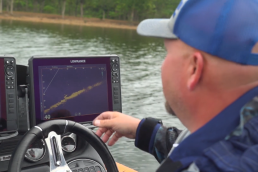Subtler Swimmers
SHARE THIS POST
In the July/August issue of MidWest Outdoors magazine, we discussed a variety of subtle swimming lures for bass. Here, let’s examine a few additional details about subtle swimmers—not just for bass, but for walleyes, pike and panfish, too.
The soft plastics we discussed were long, flexible paddle tails with subtle vibrations designed to catch bass, walleyes or other species in the face of extremely clear water and/or significant fishing pressure. Some come prerigged on jigheads; others come in bulk packs, and you rig them on any jigheads you choose. The main things that make this new breed of tails different from traditional “grubs” is that they are longer, softer and often come in subtle clear/smoke/shad color patterns, as opposed to darker or brighter shades.
From their inception, traditional grubs like Mister Twister Meeny and Teeny curly-tails also came in smoke color patterns, but were a far cry from the nearly invisible tails on today’s market. At the time, anglers equated these “low-vis” tails more with catching walleyes or crappies in clear water rather than with bass. Three-inchers were popular, while 4-inchers were considered a bit too large for walleyes; we now know better, and today, 4-inch tails are commonly used for walleyes—especially when you’re after bigger ones.
The question often arose as whether to rig curly-tails up or down. The answer is…it depends. If you rig them with
the tail curling down, the tail catches more water as they sink, accentuating the tail wobble. However, if you rig them with the tail curving upward, they excel for subtle swimming retrieves where you want to minimize tail action and vibration. You might not think these were significant differences, but over the years, the principle has proven itself time and again.
The same rigging works with the newer, more slender, subtler paddle tails so popular with West Coast bass anglers. They typically come rigged on jigheads with the paddle tail facing down. If you take the grub off the jighead and rotate it 180 degrees so the paddle points up, it will swim even more subtly. Again, you’d think this was splitting hairs, but once again, it has paid big dividends in tournament situations, catching bass from areas already fished by other competitors throwing similar clear-bodied grubs with the tail rigged downward.
Are you enjoying this post?
You can be among the first to get the latest info on where to go, what to use and how to use it!
And so it goes. Innovative anglers always seem to find some new wrinkle or adaptation to refine their fishing success. Sometimes, little things make a big difference. And in many cases, adding up enough little things to put the odds in your favor can result in catching more or bigger catch, or in tournament competition, a win.
Switching to a smaller profile, less-visible color pattern, and turning the paddletail upside down (top) creates a subtler presentation that sometimes pays big dividends, especially in clear water, amidst fishing pressure and under cold front conditions.
Dave Csanda has enjoyed 40 years in the fishing communications industry at In-Fisherman, Angling Edge and now, as editor of MidWest Outdoors. He is an inductee of both the Minnesota and National Fresh Water Fishing Halls of Fame.
Did you enjoy this post?
You can be among the first to get the latest info on where to go, what to use and how to use it!
Dave Csanda
Dave Csanda has enjoyed 40 years in the fishing communications industry at In-Fisherman, Angling Edge and now, as editor of MidWest Outdoors. He is an inductee of both the Minnesota and National Fresh Water Fishing Halls of Fame.

